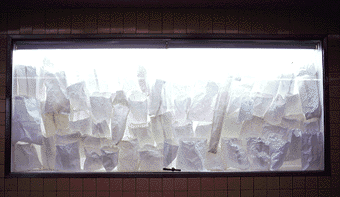 Anna
Louise Rowe, Speculum in Vellum,
Mirror etched with text, 1996
|
Secret Archives is
the latest in a series of curatorial projects by Rozalind
Drummond that situates work, sympathetic to her own, in
dialogue around a theme central to her activity as a
visual artist.1
The exhibition brings together the work of ten
contemporary artists who share a native tendency to
collect, hoard and accumulate material, and explores the
possibilities of the archive when employed as form in
visual art. Rozalind Drummond's contribution to the
exhibition, archive, serves as an introduction to
the show as a whole. The work is a found collection of
portrait photographs dating from the 1950s or 1960s,
displayed in neat rows in two of the glass-fronted
display cases that form the exhibiting space at Platform
2. Material similar to this has formed the basis of
Drummond's exhibiting practice over the last few years.
In this instance, however, the found photographic
"evidence" is presented without any of the
support material which Drummond usually employs to direct
the viewer's interpretation of the work in accordance
with her intention. Archive is a work in genesis.
It is also a form of fiction similar to that found in the
novels of postmodern writers George Perec and Alain
Robbe-Grille; as viewers we participate with the artist
in constructing a meaning or narrative to accompany these
superficially homogeneous images.
Sarah Curtis and Caroline
Eskdale both present evidence of fictional lives.
Somewhere behind Eskdale's Reconstructing a Collection
lurks the figure of an amateur rock collector whose
selection process relies on the aesthetic qualities of
specimens rather than their scientific value. Sarah
Curtis invites us to speculate on the motives and
activity of an urban folk-artist, who devotes their time
to carving the likenesses of popular TV stars and Greek
heroes on blocks of soap.
Using the image of an African-American woman from a
book of glossy documentary photographs as a reference,
Eliza Hutchison has assembled a collection of personal
affects. Mira makes three dimensional the identity of a
woman who has been flattened out into a fetish by the
photographer's lens, but also reminds us of the creepy
activity of the fetishist or fan. Rose Nolan's Another
Time, Another Place documents a period in her life
when her interest in Communist Russia became an
obsession. Her display of memorabilia, tourist snaps, and
clothing made in imitation of Constructivist design blurs
the distinction between homage and imitation.
The care and storage of completed work is presented as
a generative activity by Simone Slee. Her recent modular
work made from folded and sewn tissue paper is shown as
we would imagine it stored in the artist's studio, the
configuration suggesting possibilities for future
exhibition of the work. Sally Ross also takes the viewer
into her work environment with a collection of working
drawings, photographs and found material. As an archive,
the collection takes on the appearance of a dippy
sociological project, combining documentation of social
embarrassments, temper tantrums and face pulling, with
research on recent trends in interior design. Anne-Louise Rowe's Speculum
in Vellum appears as a reply to the curatorial theme
rather than a complicit response. Her installation of
mirrors, inscribed with mannered handwriting, initiates a
complex series of associations and metaphors on
subjectivity, context and interpretation.
For Lauren Berkowitz and
Megan Marshall, the activity of forming and arranging
collections is primary to their activity as artists. In
the context of the exhibition and the gallery's location,
Berkowitz's and Marshall's work loses some of its purely
formal qualities and takes on more familiar connotations.
Berkowitz's mass of paper bags, pressing against the
windows of the display cases, adds weight to the gesture
of carelessly disposing of a paper bag. Marshall's
assemblages of clear plastic, pins, and stockings fully
embrace their bodily connotations. With its connections
to traditionally feminine, time-consuming domestic
activities, her catalogue of abject body images makes
tangible the cathexis of frustration or desire into
laborious and methodical work.
Incorporating the activities of curation and research
(the fictional identities of archivist, detective, and
collector) into her total work and practise, Drummond
draws attention to the possibilities that arise when an
artist broadens their activities to include areas that
are normally considered to be tangential to the
production of visual art. Like Perec, Drummond aspires to
make a profession of playing the dilettante. She displays
how the resulting product, despite its heterogeneity, is
one that can be significant and engaging in its process.
Andrew McQualter
1996
1.
Drummond curated "faktura" (Stop22, Melbourne,
1995) and was a participating artist in "the modern
star series", (Welcome Hotel Video Screen,
Melbourne, 1996 Next Wave Festival).
|


